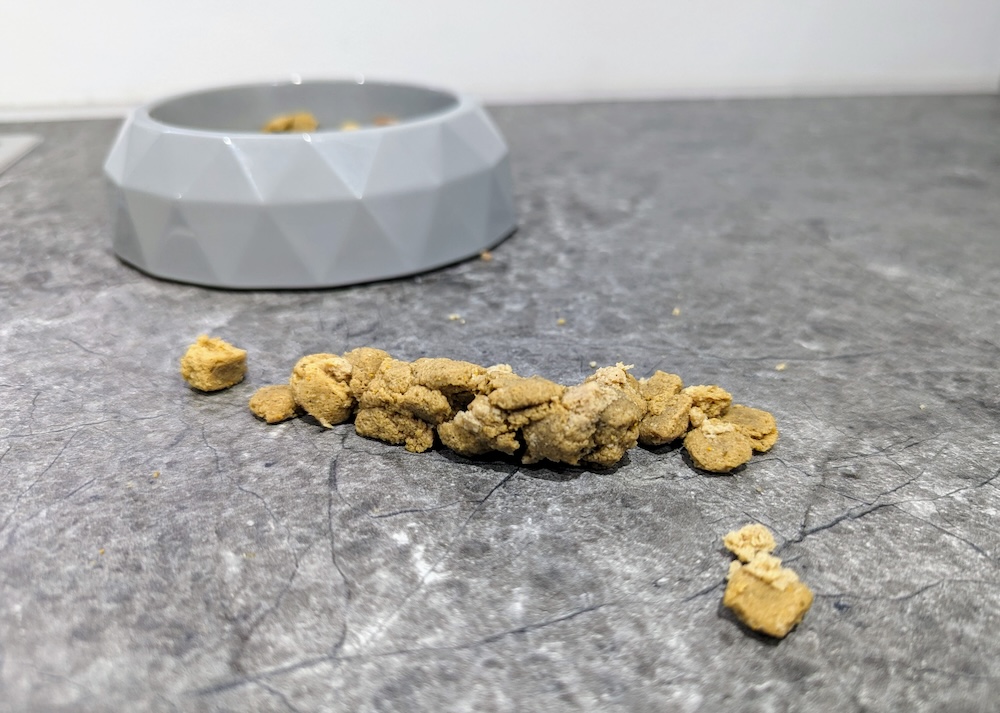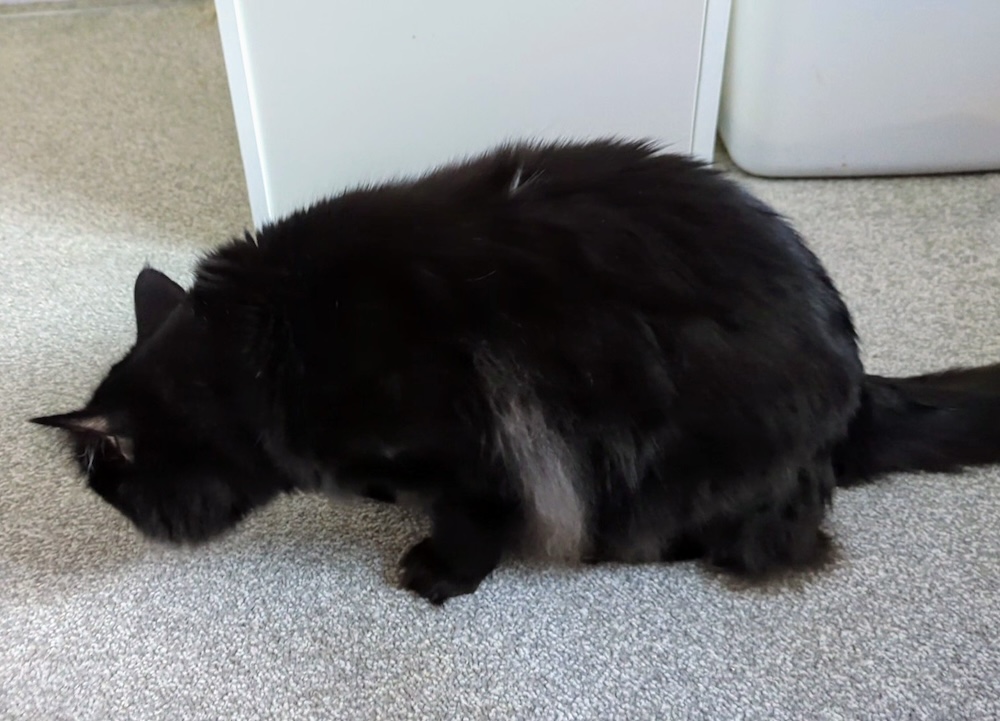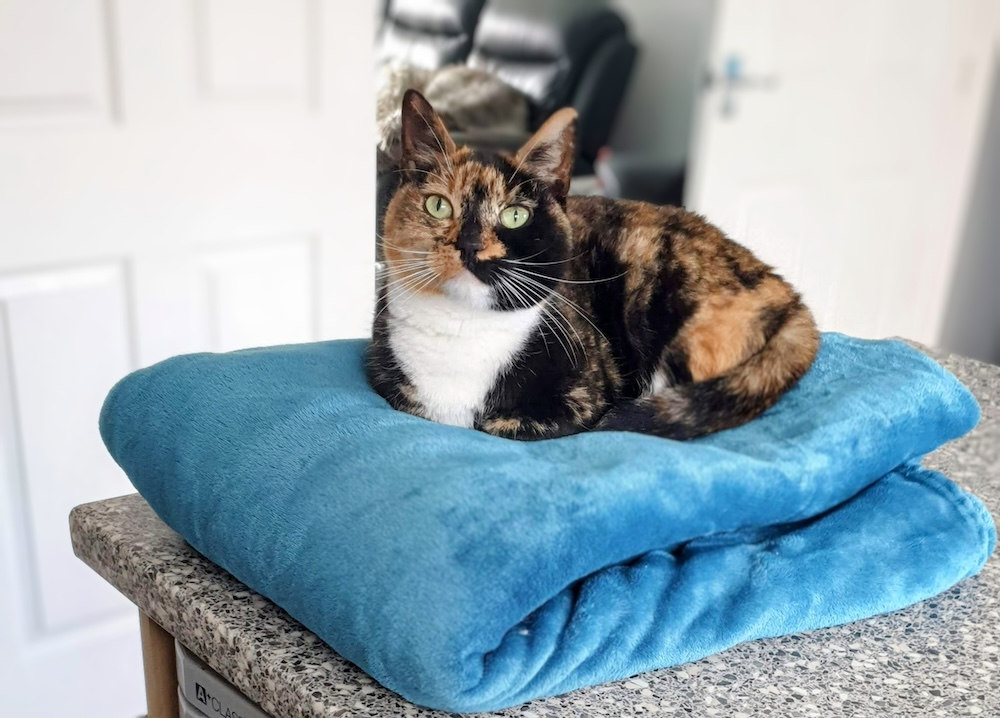Hi, I’m Dr. Karyn! Read my introduction to learn more about me and meet my five funny cats: Clutch, Cyril, Alex, Zelda, and Zazzles.
Ask me what makes me jump out of bed like a kid on Christmas morning:
It wasn’t a fire alarm, or a barking dog, and it sure wasn’t an alarm on my phone. No, the one thing that will get me – and any cat owner – up on my feet and wide awake is the guttural urge of a vomiting cat.
Now, I don’t know if this is a woman, pre-programmed maternal thing (I don’t have children), and a cat Dads out there, please let me know if I’m wrong, but why is it that I can go from deep sleep that sleep to rush my cat to a hard surface in less time than it takes my husband to roll over on his other side and continue snoring? There was a near-miss situation where Zazzles, who prefers to haunt our bedroom at night, decided to start his digestive evacuation sequence from a convenient location above our bedhead. Reece (the aforementioned husband) objected vehemently to disturbing him from his slumber, so I promised that next time I would let the cat puke on his sleeping head. Unfortunately, this particular situation has not been repeated.
I’m sure you’ve found yourself in similar situations, and probably want to know
- Why do cats often vomit?
- How often is too often? And….
- When is a vinegar not a vinegar?
Please, join me on a little journey as we look at the ins and outs of feline emesis.
When is Vinegar Not Vinegar?
Regurgitation, Vomiting, and Coughing Up a Hairball
One benefit of having five cats at my disposal is that, inevitably, one of them will exhibit one, more, or all of the weird and wonderful cat behaviors we all know and tolerate. Clutch has mild inflammatory bowel disease (IBD), and his digestive pyrotechnics will grace us from time to time, usually due to his tendency to steal food that isn’t part of his prescribed diet. If you watch my video, you may notice that his technique is slightly more subdued than the violent, noisy belly lunges that we often see our cats engage in, probably because he is so well trained. But, he still shows us the classic stomach contractions that indicate vomiting.
Sadly, regurgitation isn’t so easy to capture on film, as we rarely get advanced notice that it’s going to happen (I say sadly because, in the absence of a cat model, I had to do the demonstration for the video). One of the main differences between vomiting and regurgitation is that there is no, or very little, stomach involvement, and what is produced is very similar to what is ingested. So many cats will happily have a second attempt at eating it, unless the dog gets there first. Regurgitation occurs when the food (or object) that has been swallowed is rejected before it enters the stomach, so it exits the tube-shaped esophagus. In most cases, this is the result of eating too quickly, or due to the accumulation of hair (a ‘pre-hairball’) in the esophagus. There are some more serious causes of regurgitation, and if you want to know more, check out our article on Cat Regurgitation vs. Vomiting.

Speaking of hairballs, when you watch Zelda in our video, you’ll see why it’s often referred to as ‘coughing up’ a hairball. Neck extended and head up, accompanied by a rough, wheezing cough, certainly looks like a breathing problem, but this posture is classic for trying to get a hairball out. So why is it different from vomiting or regurgitation?
If a hairball reaches the stomach, it is usually set to continue on a one-way journey to the exit. However, if the hairball gets stuck entering or exiting the stomach, or the intestines, we can have regurgitation, vomiting, or constipation as a result. Coughing occurs when hair builds up higher in the esophagus, irritating the pharynx, where the oral cavity, nasal cavity, esophagus, and trachea meet. This triggers the classic hairball cough, but doesn’t always result in the expulsion of a hairball, as there may not be one yet. Hairballs accumulate over time, much like hair in a shower drain. You don’t get clogged after a shower, but over time, the hair attracts more hair and other debris until you get a solid, slimy mass. When you find a classic hairball on your carpet or bed (which often looks alarmingly like a poo, especially if it’s the handiwork of Zelda with raven hair!), this hairball is usually vomited; A hairball cough is usually not productive. So if your cat is developing hairball coughs, it’s a good time to be more proactive about dealing with them before they become a more serious issue.

Why Do Cats Often Vomit?
There are many different reasons why cats vomit, and, even if it seems like it sometimes, it’s not to annoy us! Vomiting can be a sign of serious illness, so it shouldn’t be ignored, but they seem to do it more often than dogs, and some cats do it more often than others. I have two “vomit” cats; one who died of old age a few years ago, and Clutch. Both had extensive investigations (bloodwork, x-rays, ultrasound), and both had completely normal results. I was able to manage their conditions by putting them on food for sensitive stomachs, but they were prone to occasional flare-ups, and Clutch threw up hairballs more often than he seemed to pass on his poop.
Cats can also suffer from pancreatitis and a condition known as triaditis, which can cause gastrointestinal upset and vomiting. Research has shown that more cats likely suffer from this condition than we realize, but in many cases, the signs are subtle enough that they may not end up at the vet, or they may recover before more specific diagnostics are performed. that review.
The hairball factor is likely to be a big contributor to the vomit cat scenario, as these slimy little things can cause a temporary blockage and slow everything down, causing vomiting or regurgitation that resolves just as quickly as it looks.
How Often Is Too Often?
This is a tricky one to answer because I don’t want to tell you not to worry if your cat is vomiting. Technically speaking, any and all vomiting is a sign of a problem, and when in doubt, it’s always better to get it checked out. I can give you some tips about what I would consider an acceptable vomiting/regurgitation/hairball situation, but remember that every cat is different, and what is considered ‘normal’ for one , may not be normal for another. .
I Don’t Worry When
- Clutch (with IBD/sensitive stomach) vomits once a week or less, and is otherwise fine and eating
- Other cats vomit once a month or less, and are otherwise fine and eating
- Either cat ‘coughs up hairballs’ once a week or less
- Either cat regurgitates once or twice a month, and is otherwise fine and eating
I Worry About When
- The clutch throws up more than once a week, or seems bad
- Any of the other cats vomit more than once a month, seem unwell, or lose their appetite
- Neither cat coughs up hairballs more often than once or twice a week
- Any of the cats regurgitate more than twice a month, seem unwell, or lose their appetite
- Any of the cats, other than Clutch, continue to vomit or regurgitate every month, even if it’s only once
- Either cat vomits or regurgitates more than twice a day

Ways to Reduce the Vinegar of Life
So now you know that life with cats is bound to involve a little vomit every now and then, but that doesn’t mean we should sit idly by. If you notice an increase in the frequency or consistency of your cat’s upchuck, but they seem clear and well and are eating and drinking normally, there are a few things you can implement to improve their gastrointestinal performance:
- Extra grooming to reduce how much hair they shed.
- Different diets – if you think their current diet doesn’t agree with them, there are thousands of different options you can try – raw, fresh, hairball diet, sensitivity diet, freeze-dried that food…talk to your vet about what they suggest, and remember to transition to a new food gradually. You don’t want it to get worse!
- There are pastes, oils, and supplements to help support a healthy digestive system and get rid of hairballs, some available over-the-counter or online, and some your veterinarian can prescribe for your cat.
Take comfort in knowing that it’s not unusual for the average cat to throw up, regurgitate, or throw up hairballs from time to time, but it’s helpful to recognize which ones it is. You know your cat better than anyone else, and if you’re worried something is wrong, you’re probably right, and it’s always best to seek veterinary advice.
In the meantime, I’m thinking of making an alarm clock that looks like a vomiting cat – let me know if you want to invest!




